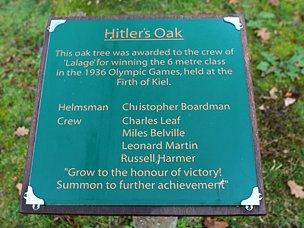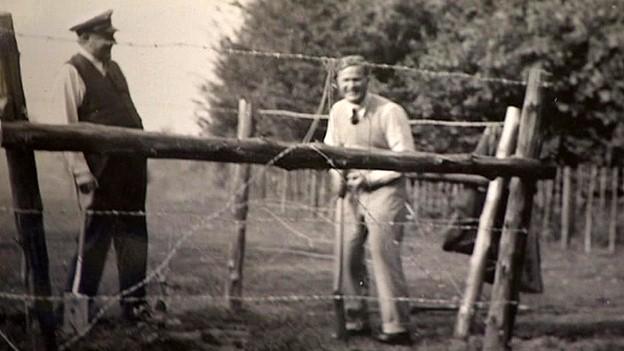Norfolk How Hill 'Hitler's oak' Olympic gift saved
- Published

Christopher Boardman (top left) was the helmsman of the gold medal winning British yacht Lalage
An "historically significant" oak tree given to a 1936 Berlin Olympics gold medal winner by Adolf Hitler has been saved for future generations.
The "Hitler's oak" sapling was given to Norfolk helmsman Christopher Boardman, who planted it at his home in How Hill.
The How Hill Trust decided to pollard, external, or prune, the tree despite being told it was "unsafe" having never recovered from the 1987 Great Storm.
"It looks slightly odd, but it's done remarkably well," said a spokesman.
'Overtones of Hitler'
The oak saplings were given to all gold medal winners at the 1936 Olympics and received their nickname because of the Nazi leader's association with the Berlin Games.
Four came to the UK after the games to mark gold medals in yachting, double scull rowing, 4x400m relay athletics and 50km walk athletics.
Mr Boardman, who died in 1987, was the helmsman of the British yacht Lalage, which won the gold medal in the 6-metre class.
Simon Partridge, director of How Hill Trust, which now looks after the estate on the Norfolk Broads, said: "This tree is historically significant to the UK.
"Some people do think it's got the overtones of Hitler and the Nazis, but the Hitler oak originated from the '36 Olympics and that was prior to World War Two.
"The oak that came here was only one of four that came out of Berlin to Britain in '36 - it's the last one standing and it was in pretty poor condition."
Tree surgeon Ashley Clarke said the tree was pollarded in early summer and "looked pretty drastic" when the work was complete.
"It was worth putting the effort in to save something like this," he said.
"If it had been any other tree we'd have just felled it, but because of it's historical value we were determined to try save it.
"As soon as you cut the top of the tree it will go in to survival mode. Basically we're shocking back to life, that forms another canopy and if it's properly managed it should easily outlive us all."
'Jolly good'
Mr Boardman, one in a crew of five, refused to go to Berlin to collect the tree and his gold medal as he "didn't like what was going on in Nazi Germany", said Mr Partridge.
"One of the crew members who did go also picked up the sapling and they decided that as Christopher was the helmsman it should come here so it was planted at the rear of the house in September '36."

The How Hill Trust hopes to seed trees from the oak's acorns in the New Year
Long before the gale force winds of 1987, Hitler nearly destroyed the tree by blowing it up during World War Two.
Holly farmer Peter Boardman, 81, the Olympian's nephew, said: "I was away at school at time but a bomb was dropped about 25 yards from the tree, it made a big hole in the ground. There was shrapnel embedded into the house, it was very close.
"I'm very proud of the tree and so glad it's still alive. I'll admit, after the '87 storms I remember walking up the hill here to see how the tree was.
"Pollarding of oak trees is a jolly good thing to do."
How Hill remained in the Boardman family until Mr Boardman's father, Edward, died in 1950 and the estate was split up.
Eventually in 1966 the marshes, woodland and gardens were bought, along with the house itself, by Norfolk County Council Education Department.
It came under the control of the How Hill Trust in 2002.
After pollarding the oak produced "a good crop of acorns", said Mr Partridge.
They have been stored in the hope of "setting them early in the New Year and continuing the line".

Christopher Boardman planted the tree at How Hill House in September 1936
- Published9 December 2013
- Published30 November 2013
- Published12 April 2013